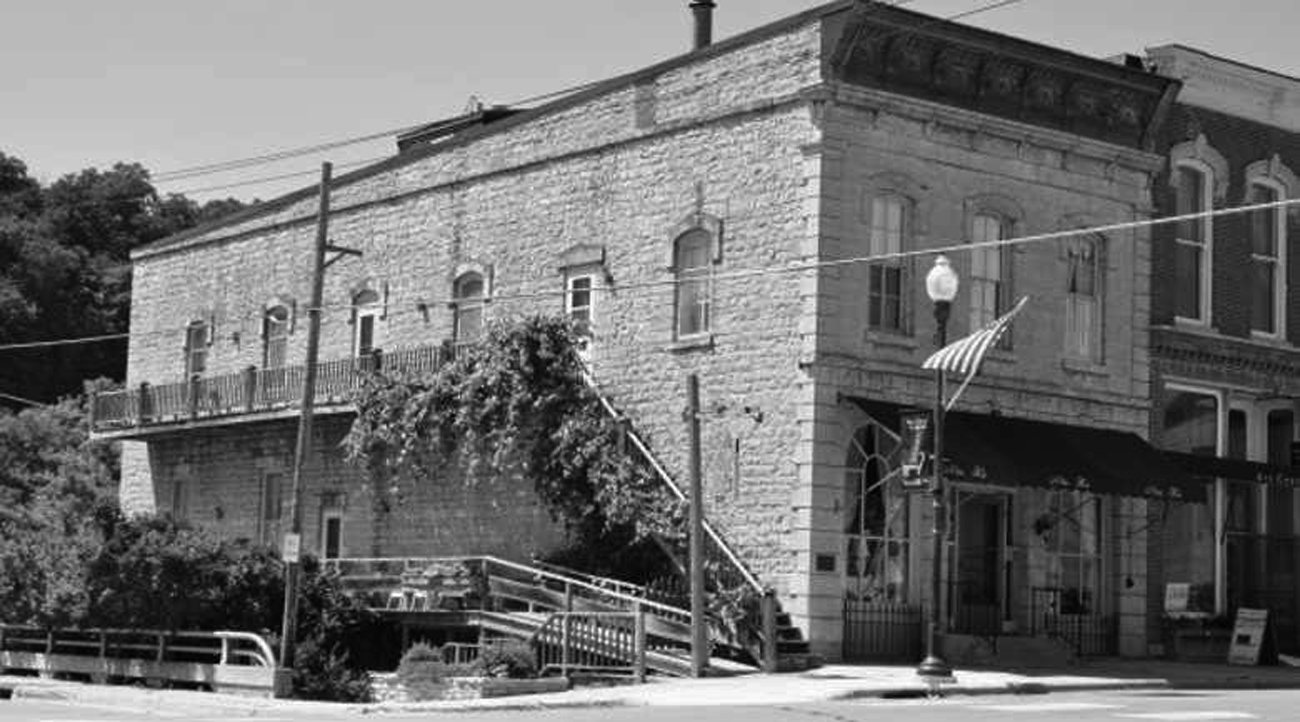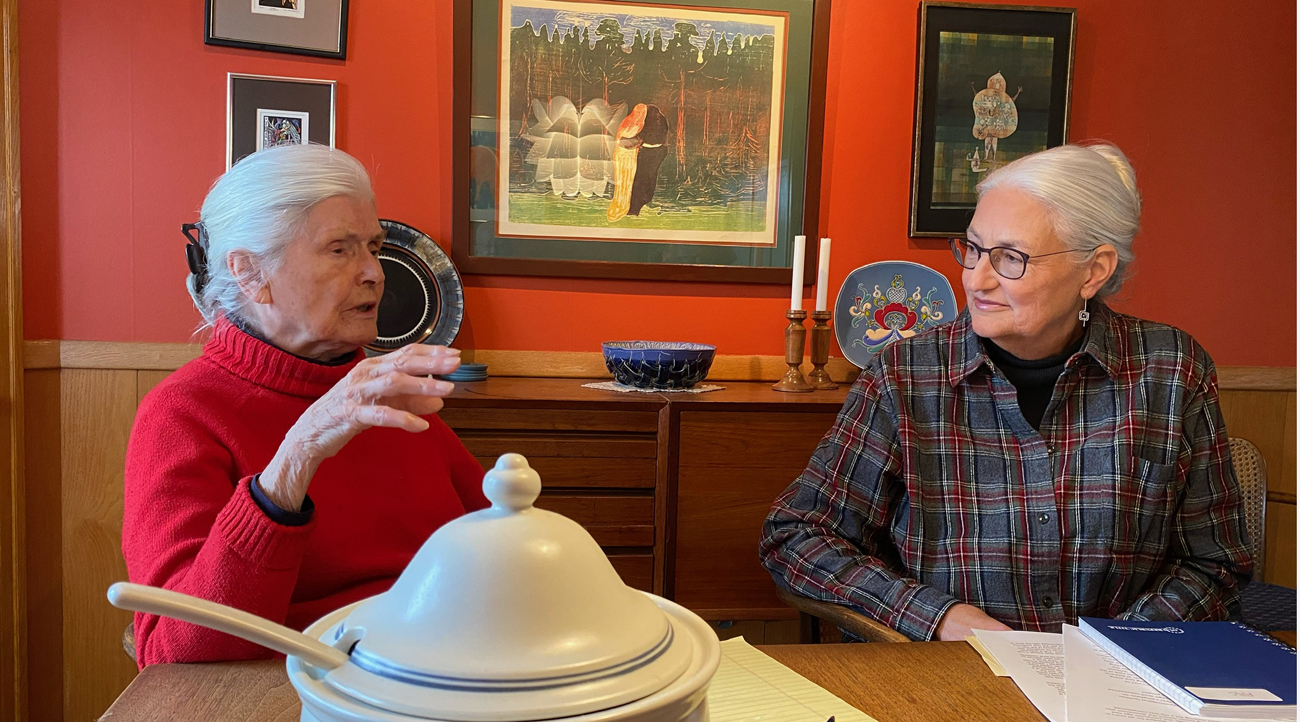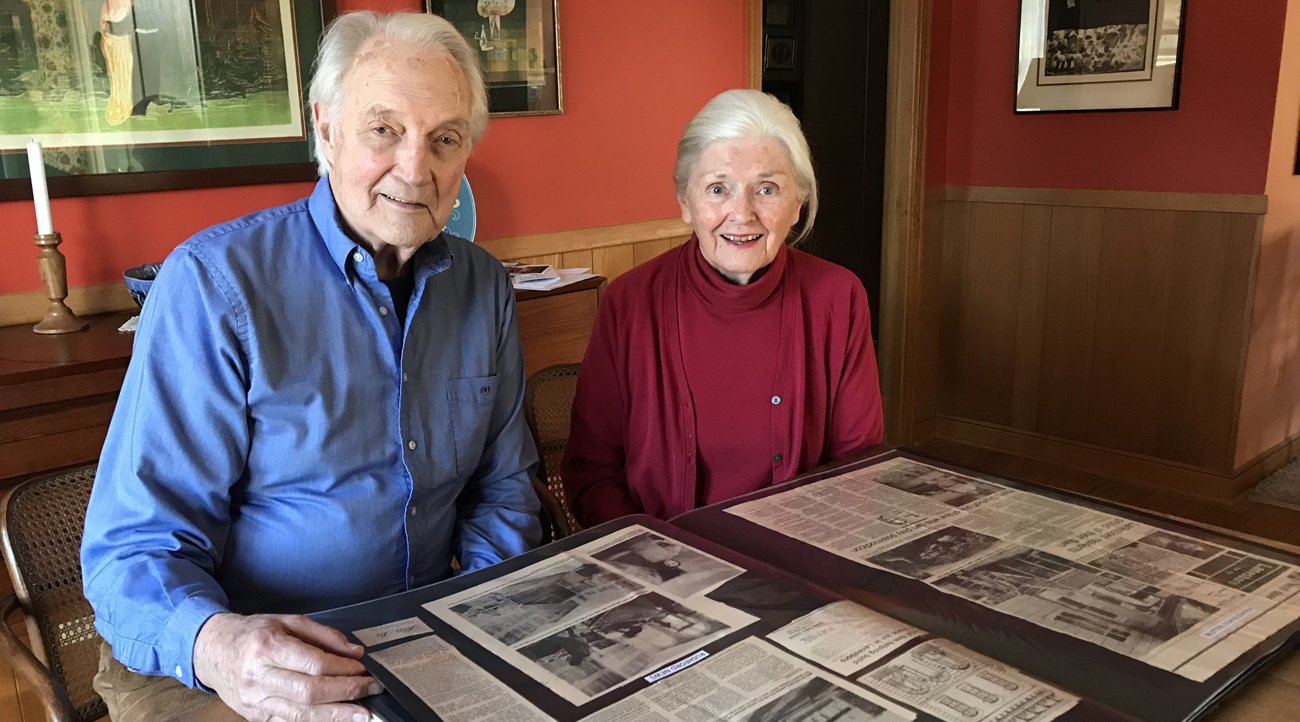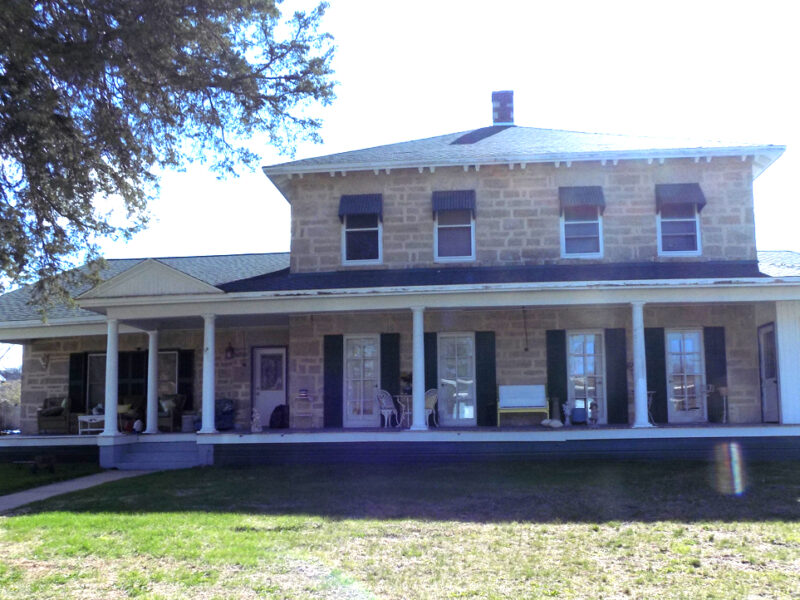Jack and Nancy Bratrud at their home in Preston. They are shown with their scrapbook documenting the media attention Mrs.B’s generated, which helped put Bluff Country on the map as a tourist destination. (Photo by John Torgrimson)
It All Started with Mrs. B’s
Editor’s Note: The Current Interview is a recurring series of conversations with individuals who have had a positive impact on area communities.
LANESBORO — Jack and Nancy Bratrud launched a new life for themselves when they moved to Lanesboro in 1980, creating one of the first Bed and Breakfasts in Minnesota. That one action kicked off the explosion of tourism and economic development in the entire Bluff Country region, which continues to this day. Loni Kemp sat down with Jack and Nancy, who generously shared their story about how it all began.
Q. What made you two think about leaving your successful careers in 1980?
Jack: We each had worked for twenty years in Minneapolis, Nancy with the US Department of Housing and Urban Development (HUD), and I ran my own corporate facilities planning firm. We had already sold our home before our sons graduated from college, because we had the urge to look for a life less complicated. So we visited Lanesboro.
Q. How did Lanesboro become your focus?
Nancy: I was overseeing a HUD apartment project in Lanesboro in 1980, and was invited by the local leader of the project to come down for our review meeting and then stay for the Fourth of July. Jack came along, and while I worked, just for the fun of it, he looked at some country properties for sale. We ended up buying one hundred beautiful acres in nearby Big Woods without any idea of how we would use it. It was secluded, quiet, and wild! A year later, another Lanesboro resident invited us to look at the empty three-story 1872 stone building on a corner of Parkway. Formerly a furniture store, funeral parlor, and offices, the historic building attracted us, and we immediately purchased it. “Take the path less travelled” was our mantra.
Q. What made you think of turning the historic building into a country inn?
Nancy: At first we considered creating an office for Jack’s design work, or upscale rental housing. When we visited our sons at college out east, we had stayed in a family home in Vermont that was open to houseguests. There were similar accommodations in other small towns we visited, and these comfortable places were so much more to my liking than the usual motels I stayed in around Minnesota when working. New England showed us another lodging style, and so we settled on making our stone building into a quiet, historic country inn.
Q. How did you repurpose the old building?
Jack: My space planning experience helped me see that by moving the stairs and centralizing the front door, we could accommodate ten guest rooms and eleven bathrooms, as well as a lower level kitchen and dining space. We would have to add water, sewer and electric wiring to our project, but we saw great potential and were excited to retain the historic integrity of the exterior of the building. We later learned that Lanesboro had secured designation on the National Register of Historic Places in 1982, and our building was listed. Eventually, Historic Structure Rehabilitation Tax Credits helped the project enormously.
Q. Was the renovation process easy or painful?
Jack: From the start, the Lanesboro Bank and the City Administrator came to see us in Minneapolis, welcomed us, and pledged the town’s support. The two of us had experience and contacts in the building and furnishing business, so we had an advantage in controlling the building renovation. Bids for construction came in under budget, and a Spring Valley contractor was selected. The renovation took only four months once our plans were in place, followed by interior furnishing. We made the leap to Lanesboro, and moved into the Inn in the fall of 1983.
Q. What was the economic situation in Lanesboro at this time?
A. Jack: The early 1980s were a rough time for rural areas. The farm crisis was on, farmers were losing money, and development was at a standstill. Lanesboro had the same problems as other small towns. The trouble with Lanesboro at the time was its downtown was tired, its real estate depressed, and tourists in those days went “up north,” not to a rural town in southeastern Minnesota. Businesses were in a negative economic situation, and local investments were seen as iffy. Few people knew about Lanesboro’s designated historic district, and rumors of a state bike trail were still faint. Local folks always appreciated the real beauty of the area, but didn’t know the economic value of it.

Mrs. B’s in Lanesboro (circa 1980s) was a historic building in Lanesboro converted into an Inn at a time when small towns were feeling the effects of the Farm Crisis. (Contributed photo)
Q. How did the people of Lanesboro respond to your project?
Jack: Many Lanesboro business and retired people volunteered their assistance. The retired drug store owner literally came in and finished boxes of solid maple unfinished furniture. The antique dealer did the wood canopy beds. We were overwhelmed by their generosity and determination to make sure this project worked. A few local skeptics in town, rumor had it, were betting on the day the project would fail. Yet the remarkable thing was that regional small town newspapers started writing and photographing the project while it was still under construction. This was a big boost for us. The publicity, and the pending construction of the Root River State Trail, gave new courage for local businesses to start investing in their own innovations.
Q. What was your goal for your guests?
Nancy: When we opened for business in 1984, we tried to make every guest comfortable in one of the most peaceful, beautiful communities in Southern Minnesota. It was a rule that we never told a guest “no” in response to a request… there was always a way to meet what guests felt they needed. We served families, couples and friends with a bit of comfort, rest, quiet, and recreation. And a bit of time too! But, no radios, no computers in house, no television, no telephones, and only a little music and a few good books. And good food of course.
Q. How did you design your unique food program?
Nancy: We started as an Inn, not a “bed and breakfast,” but we had to take care of our house guests and prepare breakfasts! Then we needed to have something for dinner for these somewhat amazed strangers who had pioneered a visit to a place they really had no idea existed. Dinner and lunch offerings were added soon after we opened, as we needed the cash flow, too. Our dining space and commercial kitchen were in the lower level where the embalming area had been in the past. We got approval as a lodging and dining business establishment, with the state Health Department’s blessing.
When we visited the Amana Colonies, we enjoyed the style of placing guests at tables together with strangers, and serving the food family style. “Pass the platter and help yourself.” This allowed us to seat more people and prepare just one menu, but offer several courses for everyone to help themselves. Our courses included an appetizer, soup, then salad, the entree, and last, several dessert choices…always a cake, pudding, and pie. After dinner, I poured “Mrs. B’s Bedtime Bump” for each guest, which allowed me to greet each of our dinner guests and make them feel they were special to us.
Q. Nancy, you became famous for your creative style of cooking. Did you know you would be at the center of the food business?
Nancy: I have been cooking all my life and loved to eat well. Our former home had hosted big and small gatherings for supper, lunch or cocktail buffets. So, why not do something for our Inn guests? Actually, I didn’t know anything. I had never worked in a restaurant in any capacity, not even as a waitress. All I knew was good food and that I could cook and I loved to eat. The other good training was staying in motels all those years for work, when I had some really uncomfortable accommodations and rude hospitality.
Q. Mrs. B’s became quite a sensation in the media. How did that come about?
Jack: We were prepared, but astonished by the early publicity. When we opened, staff of WCCO Minneapolis television stayed at the inn and interviewed us for a five minute news segment titled: “A stay at Mrs. B’s and a day in Lanesboro.” The Minneapolis Tribune did a Sunday leisure section with Mrs. B’s featured on the front page. It wasn’t long before state and national magazines and newspapers took notice of our definition of guest hospitality, which was complemented by the original qualities of Lanesboro itself. Coverage included National Geographic Traveler, Trans World Airlines, Chicago Tribune, Los Angeles Times, Minnesota Monthly, AAA magazine, and newspapers too numerous to mention.
In 2009, Lanesboro was declared “The Bed and Breakfast Capitol of Minnesota” by the Minnesota Legislature. With a population of 788 people, Lanesboro had 15 Bed and Breakfasts. It claimed both the highest total number and the highest per capita number of B and Bs. Today the Lanesboro Chamber of Commerce lists seven Bed and Breakfasts and six larger inns and motels.
Q. How did momentum build for other new businesses?
Nancy: More accommodations became available in other towns along the Root River. We joined together to establish “Root River Trail Towns” to create cooperative advertisements and events that enhanced the growing public awareness of this lovely part of the state.
I later met a couple on a glacier boat trip in Alaska who told me about this place in Minnesota that had a big old cat in the hotel that would come into their room when they stayed there… and I realized they were telling me about our cat, Pete! Word was out that Lanesboro and southern Minnesota had things to see! Even old cats.
Jack: The real story is that it took just eight short years after we launched Mrs. B’s for the citizens of a dying little town to recognize the true assets of the town and make new investments to insure its success. Our Inn and the first section of the Root Rive Bike Trail was followed by other new businesses popping up, including a winery, restaurants, an art gallery, professional theater and an expanded Eagle Bluff Environmental Learning Center.
Q. How did you integrate your private life with running the Inn?
Nancy: We lived in the inn for its first four years, in a lower level suite. This enabled us to add to and make changes that met guests’ expectations. When we completed our energy efficient home in the Big Woods in 1987, we moved there to enjoy the garden, coyotes, and other friendly wildlife. Still, one of us usually stayed at the Inn overnight, or we had management staff on duty.
Q. When did you move on to your next adventure?
Nancy: After eight years of operation, we sold Mrs. B’s in 1991. We left inn-keeping with gratitude for that delightful experience, and honestly, we were getting tired, too. By then we had a grandson, and our Big Woods home was complete.
By 2000, our final adventure called us to Duluth to help our sons run their lakeside restaurant called “The Boat House.” Now we are back in Fillmore County and feel like we are home in Preston, safe and sound.

Nancy Bratrud (left) and author Loni Kemp. Loni Kemp and her husband moved from Minneapolis to Fillmore County about the same time as the Bratruds, and the two couples have been friends ever since. (Photo by Richard Nethercut)






